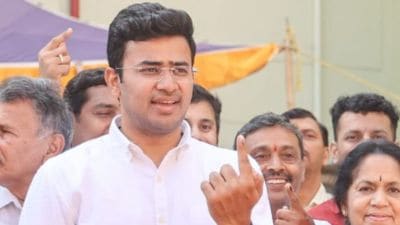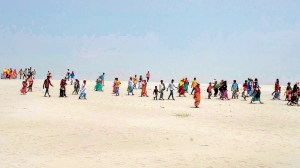- India
- International
Bhojshala-Kamal Maula mosque row: Why fingers will be crossed at this small MP town on Basant Panchami
ASI lets Hindus pray at the shrine on Tuesdays and on Basant Panchami, and allows Muslims to offer namaaz on Fridays — an arrangement that, however, goes haywire when the festival is on a Friday.
 The Archaeological Survey of India (ASI) lets Hindus pray at the shrine on Tuesdays and on Basant Panchami, and allows Muslims to offer namaaz on Fridays — an arrangement that, however, goes haywire when the festival is on a Friday. (Source: ASI)
The Archaeological Survey of India (ASI) lets Hindus pray at the shrine on Tuesdays and on Basant Panchami, and allows Muslims to offer namaaz on Fridays — an arrangement that, however, goes haywire when the festival is on a Friday. (Source: ASI)
Basant Panchami, which marks the beginning of spring, and is believed to be the birthday of Goddess Saraswati, is associated with the colour yellow. In Dhar town of Madhya Pradesh, some 250 km from the state capital and home to the Bhojshala-Kamal Maula mosque, a shrine claimed by both Hindus and Muslims, saffron is dominating the air in the days before the festival.
The Archaeological Survey of India (ASI) lets Hindus pray at the shrine on Tuesdays and on Basant Panchami, and allows Muslims to offer namaaz on Fridays — an arrangement that, however, goes haywire when the festival is on a Friday. This happened in 2006 and 2013 — and this year, Basant Panchami is again on a Friday, February 12.
Hindus have been insisting on exclusive access to the shrine all day, while Muslims would like to offer juma prayers between 1 pm and 3 pm. A slew of petitions in the High Court, at least one of which demands a permanent resolution of the dispute, have sharpened tensions and increased the challenge before the BJP government.
The “liberation” of Bhojshala was one of the major issues before the 2003 Assembly elections that dislodged the Congress. The same organisations that once targeted the Digvijaya Singh government are now gunning for Chief Minister Shivraj Singh Chouhan for calling in unprecedented bandobast to ensure that Hindus clear the premises in time for the namaaz.
The ASI has fixed the slots between sunrise and 12.30 pm, and 3.30 pm to sunset for Hindus, and 1-3 pm for Muslims. In 2006 and 2013, the police escorted a handful of Muslims to the shrine and back after they had offered a token namaaz.
In both those years, members of rightwing organisations who tried to break the law were beaten by police. This year, as police preparations have progressed, the Dharma Jagaran Manch (DJM) and Vishwa Hindu Parishad (VHP) have tried to match their scale by taking out massive rallies and inviting Hindus to reach the shrine on Friday. Saffron flags and posters are all over the town.

Thousands of Muslims — many more than is usual — offered prayers at the shrine last Friday, and as they wound their way back, zigzagging through barricades, the administration sensed a challenge much bigger than the one it had anticipated a month ago.
The government has made it clear that it would follow the ASI formula, come what may. The Hindu organisations have responded that they would not enter the premises at all on Friday if the government does not tell them categorically that namaaz would not take place. On Tuesday, they held a satyagraha outside the shrine for the first time since 2003 to protest the administration’s decision not to accept their demands like reducing the size of some barricades and removing others. Their argument: there are several mosques in Dhar, but only one Saraswati temple; so why can’t Muslims offer namaaz elsewhere for a day?
Emboldened by the huge turnout in their rallies, the Hindu organisations have not spared Chief Minister Chouhan. Last Friday, they circulated an old video featuring Chouhan, in which he had accused the then Congress government of playing “vote bank politics”, and appeasing minorities. Chouhan had come to Dhar as part of a three-member parliamentary delegation when the NDA was in power at the Centre.
This time, the 56-year-old who throws iftaar parties and occasionally sports a skull cap, has not uttered a word — but has given strict instructions to the administration to stick to the ASI’s formula. The presence of thousands of policemen in and around the city has given Hindu organisations an idea of what to expect on Friday, but the Muslim community has expressed satisfaction with the arrangements so far.
The local Hindi media often compares the campaign to “free” Bhojshala with the Ram temple movement. On Monday, as thousands of vehicles moved through the town, “Jai Jai Shri Ram” was the most heard slogan. Sadhvi Rithambara, who was the leading light of the Bhojshala movement in the 1990s, was called by the DJM to speak in Dhar on January 24, but she claimed to have missed her flight — leading to insinuations that she had been told to stay away by “someone at the top”.
After getting caned in 2013, the Hindu organisations had threatened to teach the BJP government a lesson for sanctioning the use of force. Minister Mahendra Hardia, who visited injured cadres at the instance of the CM, had a tough time after angry activists forced him to wear a green gamchha to allege that the BJP government too was trying to “appease” Muslims.
milind.ghatwai@expressindia.com
More Explained
EXPRESS OPINION
Apr 27: Latest News
- 01
- 02
- 03
- 04
- 05










































